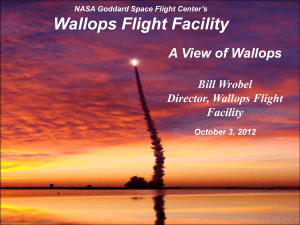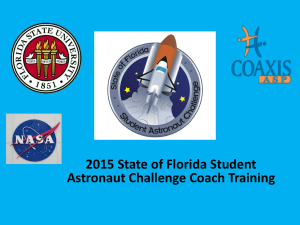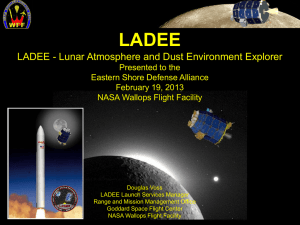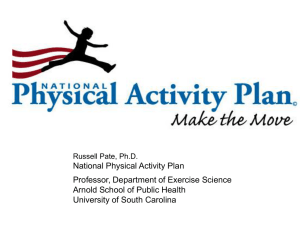WFF_NSF_Brief_Rev_1
advertisement
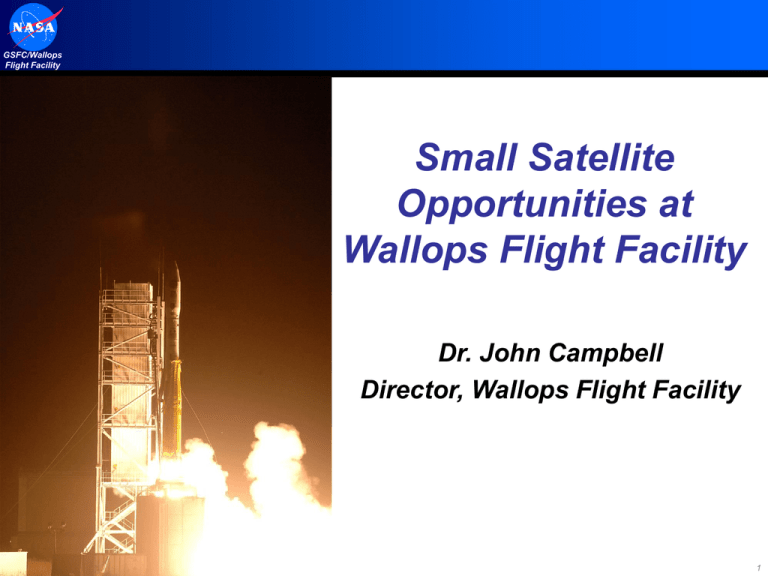
GSFC/Wallops Flight Facility Small Satellite Opportunities at Wallops Flight Facility Dr. John Campbell Director, Wallops Flight Facility 1 GSFC/Wallops Flight Facility The Small Satellite Paradox Small satellites are not funded (nor built) because of a lack of affordable launch opportunities and Affordable small satellite launch capabilities have been slow to emerge due to a limited market 2 GSFC/Wallops Flight Facility Small Satellite Launch Enablers 1. Low-cost small launch vehicles 2. Inexpensive & responsive launch ranges 3. Ride sharing 3 GSFC/Wallops Flight Facility Low-Cost Launch Vehicles • Get-Away Special & Hitchhiker once served as the premier means for orbiting small satellites • New small ELVs are moving to fill the void – Minotaur I, IV, & V – SpaceX Falcon 1 – Etc. • Essential characteristics of new vehicles – – – – Simple pad infrastructure Short time from arrival at range to launch Much lower cost per pound than current vehicles Streamlined range support requirements (e.g., data services, personnel accommodations) 4 GSFC/Wallops Flight Facility Small Launch Vehicle Options Conducted from Wallops Trans-Lunar LEO Mass Injection Mass Launch Vehicle kg (est.) kg (est.) Existing Options Pegasus 420 N/A Taurus 3110/3113 1530 350 Minotaur 1 580 N/A Near-Term Options Minotaur 4/5 1680 490 Falcon 1 620 100 Falcon 9 ~9000 ~2000 Price ROM ~$30M ~$40M ~$20M ~$30M ~$10M ~$30M 5 Small Satellites to the Moon GSFC/Wallops Flight Facility • Small ELVs (e.g., Minotaur V) launched from Wallops can transport 350-500 kg (payload is ~50%) to the Moon • Can provide low-cost options for Science and Exploration needs – – – – Remote sensing orbiters Impacters Small landers Communication & navigation orbiters 6 GSFC/Wallops Flight Facility Small Satellite Launch Enablers 1. Low-cost small launch vehicles 2. Inexpensive & responsive launch ranges 3. Ride sharing 7 Launch Site on Wallops Island GSFC/Wallops Flight Facility 8 Mid-Atlantic Regional Spaceport (MARS) GSFC/Wallops Flight Facility • MARS owns 2 launch complexes at Wallops • Used for Wallops small-to-medium class ELV missions • MARS is a VA & MD sponsored partnership with NASA chartered to pursue commercial aerospace opportunities at Wallops • Current agreements enable efficient work with Wallops, using multiple business models: • NASA support of MARS commercial launches • MARS support of NASA’s government launches 9 GSFC/Wallops Flight Facility Wallops Operating Areas • Wallops operational areas offer nearly unlimited mission capabilities – Restricted NASA-controlled airspace encompasses Launch Range & Research Airport – NASA airspace provides direct access to Atlantic Ocean for hazardous mission operations • Wallops location & geography provides the most efficient access to desirable mid-inclination orbits of 3860 degrees 10 GSFC/Wallops Flight Facility Low-Cost Responsive Range Operations • Wallops Launch Range is “rightsized” for small spacecraft missions – Small spacecraft missions not competing against large ELVs or Shuttle – Staff & facilities sized for small orbital missions • Wallops has a history & reputation for supporting emerging, low-cost launch vehicles – Schedule flexibility allows for development mission complications – Safety & project support culture of assisting projects during development 11 GSFC/Wallops Flight Facility Spacecraft Plus Upper Stage Arrival ~L-30 days Launch Site Integration Flow Pad ~L-14 days Range Control Center Launch! Lower Stages Arrival ~L-30 days Blockhouse 3 12 GSFC/Wallops Flight Facility Minotaur I Launch @ Wallops 13 GSFC/Wallops Flight Facility Small Satellite Launch Enablers 1. Low-cost small launch vehicles 2. Inexpensive & responsive launch ranges 3. Ride sharing 14 GSFC/Wallops Flight Facility Ridesharing • Small ELVs are still larger than necessary for many small satellites • Multi-manifesting of small ELVs is critical to ensuring that “Micro-Explorer” spacecraft (50-200 lbs.) mature as a viable class of spacecraft • Wallops has developed the Multi-Payload Ejector as a key enabler to exploit small ELVs for spacecraft smaller than 1000 lbs. 15 Multi-Payload Ejector GSFC/Wallops Flight Facility • MPE able to carry >800 lbs. of individual spacecraft – 1 primary (up to 200 lbs.) – 6 secondaries (up to 100 lbs. each) – 12 CubeSat tertiaries (up to 3 lbs. each) • Flexible – Configurable for any launch vehicle, as primary for smaller ELV & secondary for larger ELVs – Can be flown as 1, 2, or 3 segments allowing trade-offs on individual spacecraft masses/volume & orbital altitude • Low-cost & simple – – – – – • Completes payload deployments within ½ orbit Motorized spring deployments (no pyrotechnics) Sounding rocket qualified timers Single input from launch vehicle initiates all MPE events Launch vehicle provides only necessary guidance/control Rapid Integration 16 MPE Integration Flow GSFC/Wallops Flight Facility Spacecraft I&T MPE Integration Vehicle Integration & Test . . . Spacecraft (S/C) Development & Test S/C Arrival @ Wallops S/C Receiving & Inspection T-4 weeks S/C Integration with MPE T-3 weeks MPE Integration with ELV T-2 weeks T-1 week Launch Day 17 GSFC/Wallops Flight Facility MPE Simulation 18 GSFC/Wallops Flight Facility Small Satellite Launch Costs by the Pound Not by the vehicle • Component Costs, w/o Spacecraft (Wallops Launch): – MPE (NASA): – I&T (NASA): – Range Services (NASA): – Launch Vehicle TOTAL: $1.5M $300K $1.5M $16M (assumes Minotaur I) $19.3M • Payload Capacity (MPE 3-stack configuration) – MPE Structure: – 1 primary spacecraft: – 6 secondary spacecraft (100 lbs. each): – 12 Cubesats (3 lbs. each) Total Spacecraft mass for 19 spacecraft ~300 lbs. 200 lbs. 600 lbs. 36 lbs. 836 lbs • Cost per payload mass – Minotaur I: – Falcon I: $23K/payload lb. $13.5K/payload lb. 19 GSFC/Wallops Flight Facility Small Satellite Launch Enablers 1. Low-cost small launch vehicles 2. Inexpensive & responsive launch ranges 3. Ride sharing 20
